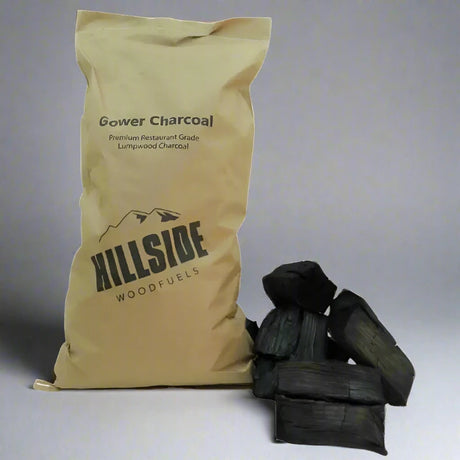Hillside Woodfuels
Kiln Dried Logs in Builders Bags (approx. 0.6 cubic meters)
£130.00£145.00Unit price /Unavailable
Introduction to Wood Fuels
Wood has been used as a fuel source for thousands of years. From heating homes to cooking food, wood fuels have played an essential role in human civilization. In recent years, interest in wood as an energy source has expanded due to its renewable nature and potential to offset fossil fuel use. We will attempt to provide a comprehensive overview of wood fuels, including their sources, production processes, applications, advantages, and limitations. The various types of wood fuels will be explored as well as their role in the renewable energy landscape.

Sources of Wood for Fuel
Wood used for fuel comes from several sources:
Forests
Forests provide the majority of wood used for fuel. Trees are harvested, processed into firewood, woodchips, or wood pellets and then burned to produce heat and electricity. Key factors in selecting tree species for fuel include density, moisture content, and growth rate. Popular choices include oak, maple, ash, hickory, and pine. Using wood from sustainably managed forests ensures a renewable fuel source.
Wood Waste
Wood waste refers to byproducts of wood processing and wood products manufacturing. Examples include sawdust, trim cuts, wood shavings, and bark. This waste wood can be collected and processed into wood fuels like wood pellets. Using wood waste reduces landfill contributions and takes advantage of this renewable resource.
Purpose-Grown Trees
Fast-growing tree species like poplar and willow can be cultivated expressly for use as wood fuel. Short harvest cycles of 3-12 years allow purpose-grown trees to provide a continual supply of wood biomass for energy production. This practice falls under the category of energy forestry.
Used Wood
At the end of its life, wood from demolition projects, spent pallets, crates, and second-hand furniture can be reused for fuel. Wood scraps and residues are collected, sorted and then burned to recover energy. However, reuse of treated, painted or coated wood may release hazardous compounds when burned.
Wood Fuel Production
Raw wood from forests and other sources requires processing to create usable wood fuels:
Firewood
The basic form of wood fuel, firewood is created by cutting and splitting logs or large branches to lengths of around 16 inches. The wood is then seasoned or dried to reduce moisture content. Softwoods like pine season faster than hardwoods.
Woodchips
Woodchips are made by chipping slash (tree tops and branches) left over from logging and forest thinning operations. Woodchips provide a consistent size for feeding biomass power plants.
Wood Pellets
To make wood pellets, raw wood is dried, milled into a powder and extruded through a press. The natural lignin in the wood acts as a binder. Pellets are typically cylindrical in shape and small in size for efficient handling and combustion.
Charcoal Briquettes
Charcoal briquettes are manufactured by burning wood without oxygen via pyrolysis. The output is then pulverized, mixed with a binder and molded into uniform briquettes. Compared to raw wood, charcoal has higher energy density.
Torrefied Wood
A specialized thermal treatment called torrefaction can be applied to wood pellets or woodchips. This process removes moisture and makes the wood more brittle. Torrefied wood has increased energy density and resists biological decomposition.
Wood Fuel Applications
Due to its solid form, wood fuel requires adapted systems and equipment for combustion. Major uses include:
Residential Heating with Firewood
The most common application is burning firewood in stoves or fireplaces to heat homes. Wood pellets can also be burned in special pellet stoves and furnaces. These systems provide warmth as well as ambiance.
Commercial Heating with Biomass Fuels
Schools, hospitals, factories, and office buildings can be heated using woodchip or wood pellet boilers. These industrial systems rely on automated fuel handling and combustion controls. Thermal output may also provide hot water.
Using Wood Fuels for Electricity Generation
Wood fuels can generate electricity via combustion in dedicated biomass power plants. Plants use furnaces and boilers to produce steam and turn generators. They may be sized from just a few megawatts up to 50 MW. Woodchip and pellet-fired plants help meet renewable energy goals.
Combined Heat and Power of Biomass Energy
Cogeneration or combined heat and power (CHP) plants burn wood to simultaneously supply both electric power and usable heat. They can achieve high overall efficiency. The heat may be used directly or to drive cooling equipment like absorption chillers.
Cooking & Heating with Wood Fuels
In developing regions, wood fuels like firewood and charcoal are commonly used for heating and cooking in homes and villages. An estimated 2.4 billion people rely on traditional wood stoves and open fires for these basic needs. Improved biomass cookstoves seek to reduce harmful smoke exposure.
Benefits of Using Wood for Fuel
Utilizing wood and its byproducts offers several advantages:
Renewability of Wood Fuels
Wood is considered a renewable fuel as long as forests are managed sustainably and regrowth equals or exceeds harvest rates. This renewability makes wood a local and dependable fuel choice.
Timber Has Lower Greenhouse Gas Emissions
Wood is considered carbon-neutral because the carbon released when burned is recaptured as trees regrow. Switching from fossil fuels to wood decreases net greenhouse gas emissions to the atmosphere.
Wood Fuels Promote Waste Reduction
Wood waste can be diverted from landfills and used productively for energy. Similarly, collecting and reusing scrap and demolition wood reduces waste disposal impacts.
Local Economic Development
Growing, harvesting, transporting and processing wood for fuel supports jobs and economic activity. And money spent on wood fuels tends to stay within the local economy.
Cost Savings: Wood Fuels are Cheaper
In certain markets, wood fuels like chips and pellets can provide cost savings for heat compared to heating oil and propane. A free or low-cost supply of wood waste also reduces fuel budget costs.
Energy Independence: Bioenergy Protects Local Economies
Locally sourced wood fuels reduce dependence on imported fossil fuels and the price volatility associated with oil and natural gas. This increases community energy resilience and security.
Limitations & Drawbacks of Wood Fuels
Alongside the benefits, utilizing wood energy also comes with some disadvantages and tradeoffs:
Wood Fuels Significantly Reduce Air Pollution
Older wood stoves and boilers emit harmful smoke and ash particles that pollute outdoor and indoor air. Upgrading to cleaner-burning, efficient models mitigates this issue.
Supply Logistics: Wood is Better Locally
Wood has a much lower energy density than fuel oil and coal, so transportation costs are higher per unit of energy. Developing consistent wood fuel supply chains is an ongoing challenge.
Adequate Resources
Suitable wood resources must be identified and made consistently available to support biomass energy systems. Competition with other wood product industries can constrain supply.
Inconsistency Can Be A Challenge
Wood's composition varies more than fossil fuels, making combustion performance less consistent. Fuel quality control and adapted equipment help improve consistency.
Storage Space Required Can Be a Limiting Factor
More storage space is required to hold an equivalent amount of energy from wood versus denser fuels like fuel oil. Proper storage conditions are also needed to prevent decay or spontaneous combustion.
Higher Labor Requirements
Handling, processing, and combusting solid wood fuels demands more labor and maintenance compared to liquid and gaseous fossil fuel systems. More training and expertise are required.
Wood Fuel Sustainability
The sustainability of sourcing and using wood for energy encompasses several environmental, social and economic factors:
Biodiversity
Harvesting trees can negatively impact forest biodiversity and wildlife habitat if not properly managed. Best practices include protecting sensitive areas, maintaining canopy cover, and preserving dead trees and downed woody debris.
Soil Health
Repeated biomass removal depletes soil nutrients over time. Regular use of practices like cover crops, erosion controls and ash reapplication improves the long-term health of forest soils.
Silviculture
Active planting, thinning and ecological forestry practices should be employed to ensure forest regrowth outpaces or equals biomass harvesting volumes. This facilitates sustainable management.
Forest Certification Programs
Third-party sustainability certification programs like FSC, SFI and PEFC help ensure wood fuel resources come from responsibly managed forests. Certification criteria include water quality, indigenous rights and more.
Fair Labor Conditions
Workers involved in tree harvesting, biomass operations and forest management should have fair pay, safe working conditions and the right to organize. Women are disproportionately impacted by indoor air pollution from household biomass cooking.
Food Security
In developing nations, overharvesting wood for fuel can reduce tree cover available for food crops and livestock grazing. Improved stoves and alternative fuels help alleviate pressures on local biomass resources.
The Future of Wood Fuels
Wood energy usage is projected to increase as technology advances and markets continue to develop:
Densified Wood Fuels
Processes that increase wood's energy density like pelletization and torrefaction will expand, improving handling, transport and performance characteristics.
Biocoal
New techniques can convert raw biomass into higher-density biocoal that replicates the properties of fossil coal. Biocoal burns cleaner and may be viable for co-firing in existing coal power plants.
Biochar
Heating biomass without oxygen via pyrolysis produces gaseous and liquid biofuels plus a charcoal byproduct called biochar. As a soil amendment, biochar enhances soil fertility while sequestering carbon long-term.
Biomass Power Generation
Electricity from wood and agricultural residues will grow as countries seek affordable renewable power to meet policy targets. Converting coal plants to biomass could extend plant lifetimes while providing dispatchable renewable power.
Combined Heat and Power
Wood-fueled CHP systems will expand due to their high efficiency. CHP meets thermal loads for large institutions while cogenerating electricity, maximizing the energy value from wood.
Waste Wood
With improved sorting capabilities, more construction debris, demolition wood and waste furniture will be recovered for fuel production rather than landfilling. This will help reduce waste disposal impacts.
Conclusion
Wood was humanity's first fuel and remains an accessible, local and renewable energy option. Sustainably sourced wood fuels can reduce fossil fuel use and greenhouse gas emissions when utilized efficiently and cleanly. Ongoing technology advances will expand wood energy's applications and environmental benefits. While wood alone cannot meet all our energy needs, it remains an invaluable part of our diverse renewable energy toolkit.

Summary
- Wood has served as an essential fuel source for millennia and remains a renewable option today. Key sources include forests, wood waste, purpose-grown trees, and used wood.
- Raw wood is processed into fuels like firewood, woodchips, pellets, charcoal, and torrefied wood. These are burned to produce heat, electricity, combined heat and power, and residential/commercial heating.
- Benefits of using wood for fuel include renewability, lower greenhouse gas emissions, waste reduction, and local economic impacts. Limitations include supply logistics, storage, air emissions, and labor requirements.
- Sourcing wood fuels sustainably requires protecting biodiversity, soil health, and food security while using practices like certification programs and fair labor standards.
- The future outlook is increased utilization of wood fuels in densified forms like pellets, for electricity generation, combined heat and power, and waste wood recycling.




























